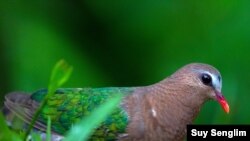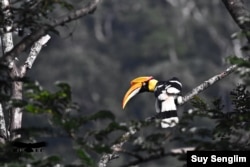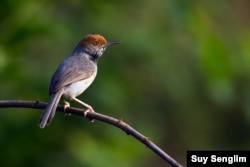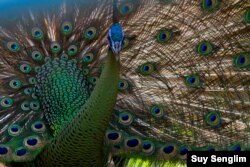In 2000, Suy Senglim met a French journalist who inspired in him a passion for photography.
To put this new-found passion to good use, since 2012 he began to capture images of Cambodia’s vast variety of birdlife. (Click to view photo gallery.)
Worried by the loss of biodiversity in his hometown of Mukh Kampul in Kandal province, Senglim created a photography project through which he hopes to raise awareness of the loss of habitat in Cambodia.
He logs methodically each new species he photographs: the common name, scientific name, its identifying features, whether the species is endangered or not.
Now the 35 year old aims to educate Cambodians about the importance of bird species and the ongoing impact of development on the country’s natural heritage.
“The biggest issue is damage to habitat and poaching. Besides that, it is due to the demand from the rich who desire wild meat and who consider mild meat chemical-free,” he said.
The Giant Ibis, Cambodia’s national bird, is currently critically endangered with its population fluctuating every year, he said.
Through his photography work he has also discovered a lack of education and law enforcement compounding the problem.
At the root of Khmer culture, Senglim says, is hunting. However, he notes, in ancient times the animals were more plentiful and the people fewer.
“If we look at the root of our culture, we can see that Khmer people have been consuming wild meat for thousands of years. And back then, the number of wildlife exceeded that of the people. Thus, consumption was possible. Now it is the opposite. There are more people than wild animals,” he said.
Educating Cambodians about the need for conservation is of utmost importance to Senglim.
“Education is very limited. And in terms of legal enforcement, only one institution is standing out, and that is Wildlife Alliance, which has conducted a string of successful crackdowns so far. However, there are few big-scale clampdowns on wildlife hunting as a whole.”
Chhit Sam Ath, executive director of WWF Cambodia, said that economic land concessions and deforestation are a cause behind the dramatic decrease in the number of trees that naturally serve as the birds’ habitat.
“We can see that Cambodia contains a vast array of wildlife along with enormous natural resources and forests. And we also know that after recent development such as economic land concessions, loggings, etc., some of which do not comply with the law, these activities severely affects the wildlife.”
Forests inside protected areas have disappeared as fast as forests elsewhere in the country. In addition to this broad-scale habitat loss, poaching and hunting is also a significant cause of forest biodiversity loss in Cambodia, according to Fauna and Flora International.
Chhit Sam Ath said that Prime Minister Hun Sen recently agreed to increase the number of forest and park rangers to curb poaching and deforestation on top of the current measures which he hopes will help limit deforestation.
“Recently, the premier has consented to increase the number of forest and park rangers to hold back illegal poaching and logging. Moreover, the government also created a special task force to crack down on those illegal acts on top of the law and governing policies in each protected area.”
Like Senglim, the WWF Cambodia executive director said that a lack of education concerning wildlife leads to reckless hunting by the people. He also appealed for an end to the wild meat trade.
“I think we should enhance education among the people in order to make them understand more and love wildlife... I want to call on the people that it is time to help protect the wildlife in our nation.”
Chantha Nasak, a wildlife specialist with Fauna and Flora International, an international conservation group, said that his organization is still carrying out a study of the number of both abundant and endangered species of animals in Cambodia. However, he said that without proper conservation and protection, Cambodian wildlife is facing a crisis.
“Through research by some NGOs and institutions on wildlife in Cambodia, we have recorded a huge number of wildlife. There are two categories of wildlife: abundant and endangered... The number of endangered species, such as elephants, can face further decreases if there are no conservation measures taken.”
To Chantha Nasak, damage to wildlife habitat is the main factor behind the drop in the number of wild animals in Cambodia. He said that the threat to wildlife habitat could be the result of deforestation, land reclamation for agricultural and economic and industrial purposes, and climate change.
“Through study and observation, there are many factors that threatens wildlife in the country. Those include damage to habitat, exploited use of land, land reclamation for business purposes and climate change. Yet, the one that stands out most is damage to habitat, which could be the result of commercial logging, farming practices and land reclamation for agriculture.”
Between 2001 and 2014, acceleration of forest loss in Cambodia was the highest in the world with a 14.4 percent increase in the rate of annual forest loss. An estimated 60 percent of the country was forested in 2009, but this had reduced to 48 percent by 2014, according to Fauna and Flora International.
On top of the establishment of agreements between some NGOs and the government to help protect wild species in Cambodia, Nasak also said that there is cooperation with communities in an effort to protect endangered wildlife in the country.
“All Cambodian citizens should join hands in the protection of wildlife, not just the NGOs and the government. It should be everyone.”
Senglim is preparing to compile a book on 100 significant bird species from the some 400 species he has so far photographed, which he hopes will be published in early 2018.
He says he looks forward to teaching in high schools and colleges to inspire a new generation of nature-lovers.
“I think it’s time to change the attitude,” he says.











